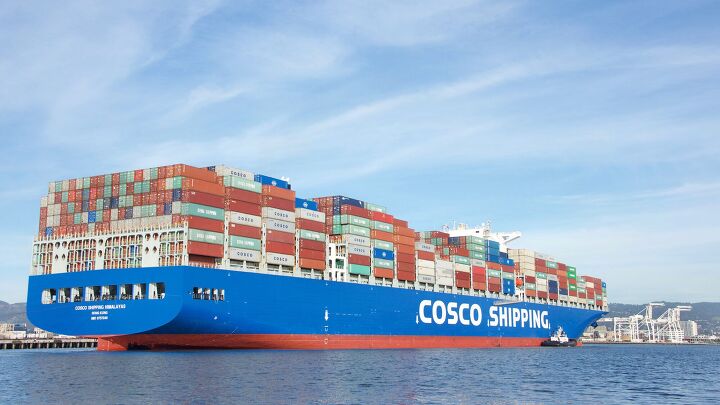China Needs More Ships to Handle Its Rapidly Growing EV Exports

China had long been a sort of a sleeping giant in the world economy, though it hasn’t been so sleepy over the last few decades. The country’s tech, automotive, and manufacturing industries have become juggernauts in their respective sectors, and the Chinese auto industry has solidified itself as a global force. Automakers there are exporting so many electric vehicles that China has found its shipping fleet – already the eighth largest in the world – is inadequate to handle the volume.
China is expanding its shipping capabilities to the point that it will become the fourth-largest fleet in the world, and it’s opening new trade routes to accommodate all the action. Companies like BYD, SAIC Motor, Chery, and others have ordered dozens of new ships as the country’s auto industry has overtaken Japan’s as the world’s largest exporter.
Though it’s growing rapidly, the Chinese automotive sector has been criticized by Europe, America, and others for the government’s heavy subsidies that make it unfairly competitive against higher-priced Western models. The U.S. government has made it nearly impossible for Chinese companies to sell vehicles here, though that could always change, and BYD has said that it has no plans to do business here.
Even so, American companies like Tesla face an uphill battle competing with Chinese automakers as it goes back and forth with BYD for world sales records. Pricing remains a challenge for electric vehicles in America for now, though, as no automaker has been able to crack the affordability nut. That, along with the highly polarized political environment here, has slowed EV adoption, so it could only be a matter of time before demand for cheaper Chinese models intensifies.
[Image: Sheila Fitzgerald via Shutterstock]
Become a TTAC insider. Get the latest news, features, TTAC takes, and everything else that gets to the truth about cars first by subscribing to our newsletter.

Chris grew up in, under, and around cars, but took the long way around to becoming an automotive writer. After a career in technology consulting and a trip through business school, Chris began writing about the automotive industry as a way to reconnect with his passion and get behind the wheel of a new car every week. He focuses on taking complex industry stories and making them digestible by any reader. Just don’t expect him to stay away from high-mileage Porsches.
More by Chris Teague
Latest Car Reviews
Read moreLatest Product Reviews
Read moreRecent Comments
- Lorenzo This car would have sold better if there was a kit to put fiberglass toast slices on the roof.
- Lorenzo The Malibu is close to what the 1955 Bel Air was, but 6 inches shorter in height, and 3 inches shorter in wheelbase, the former making it much more difficult to get into or out of. Grandma has to sit in front (groan) and she'll still have trouble getting in and out.The '55s had long options lists, but didn't include a 91 cubic inch four with a turbo, or a continuously variable transmission. Metal and decent fabric were replaced by cheap plastic too. The 1955 price was $1765 base, or $20,600 adjusted for inflation, but could be optioned up to $3,000 +/-, or $36,000, so in the same ballpark.The fuel economy, handling, and reliability are improved, but that's about it. Other than the fact that it means one fewer sedan available, there's no reason to be sorry it's being discontinued. Put the 1955 body on it and it'll sell like hotcakes, though.
- Calrson Fan We are already seeing multiple manufacturers steering away from EVs to Hybrids & PHEVs. Suspect the market will follow. Battery tech isn't anywhere close to where it needs to be for EV's to replace ICE's. Neither is the electrical grid or charging infrastructure. PHEV's still have the drawback that if you can't charge at home your not a potential customer. I've heard stories of people with Volts that never charge them but that's a unique kind of stupidity. If you can't or don't want to charge your PHEV then just get a hybrid.
- AZFelix The last time I missed the Malibu was when one swerved into my lane and I had to brake hard to avoid a collision. 1 out of 5⭐️. Do not recommend.
- 2ACL I won't miss it; it was decent at launch, but in addition to the bad packaging, GM did little to keep it relevant in the segment. I'd prefer that another domestic automaker doesn't just give up on the mainstream sedan, but unlike some of Ford's swan songs, the Malibu made an indifferent case for why they should live.


































Comments
Join the conversation
At least two car carrier ships with high end European EV cars aboard have caught fire in the Atlantic, on their way to America. The crews abandoned the ships, since there was no way to stop the fires, and the ships burned until they sank. What shipping company would be stupid enough to ship Chinese EVs across the pacific?
What can be more green than shipping an EV half way around the world?